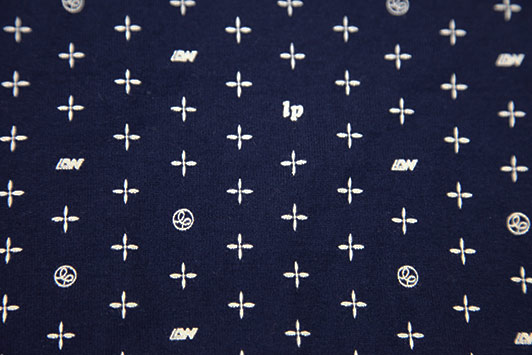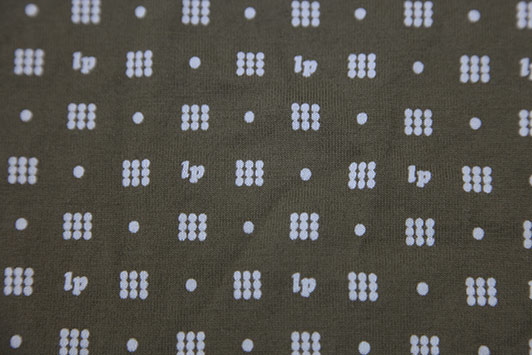 ループウィラーでは、初めての試みであります抜染プリントにトライしてみました。画像は通称トンボと呼んでいる柄のテストプリントです。抜染は、もともと浴衣や着物などの染め付けに使われてきた日本古来の伝統的な技法です。染め付けられた色を抜くわけですので、いつものシルクスクリーンオーバープリントは、逆のお話になります。もともとループウィラーの生地の染色は、なるべく色落ちがしづらいようにしっかりと染め付けていますので、このように色を抜くのはなかなか大変な仕事となります。マリンのTシャツ用LW吊り天竺を抜染プリントをしたものが画像のような仕上がりになります。完全に抜けきらないところもありますが、それはそれで抜染の雰囲気がでて、良いところかと思います。
ループウィラーでは、初めての試みであります抜染プリントにトライしてみました。画像は通称トンボと呼んでいる柄のテストプリントです。抜染は、もともと浴衣や着物などの染め付けに使われてきた日本古来の伝統的な技法です。染め付けられた色を抜くわけですので、いつものシルクスクリーンオーバープリントは、逆のお話になります。もともとループウィラーの生地の染色は、なるべく色落ちがしづらいようにしっかりと染め付けていますので、このように色を抜くのはなかなか大変な仕事となります。マリンのTシャツ用LW吊り天竺を抜染プリントをしたものが画像のような仕上がりになります。完全に抜けきらないところもありますが、それはそれで抜染の雰囲気がでて、良いところかと思います。
Here at Loopwheeler, we have completed our first ever trial for a discharge print. Shown in the photo is the test print for a design that we have nicknamed ‘Tombo’. Discharge printing was originally a traditional time honored Japanese technique used on dyed items of clothing such as Yukata and Kimono. This method of printing involves drawing out the dye from certain parts of the fabric, so it is essentially a reversal of the commonly used silk screen overprint method. We have always firmly employed methods for dyeing our Loopwheeler fabrics in order to ensure that they fade as little as possible, therefore extracting color in this way is a rather difficult task. The discharge print that we use in our marine T-shirt came out as shown in the picture above. There are certain parts of the design where the dye has not been fully extracted, however I quite like this, as I feel that this is all part of the character of discharge printing.
 アーミーのLW吊り天竺に、通称ピンポンと呼んでいる柄を抜染プリントしたものです。抜染にプリントという言葉を合わせて使っているのは、画像のトンボ柄やピンポン柄のシルクスクリーンの版を製版して、抜染剤と呼んでいるものをスキージでプリントしているからです。工程としては、プリント後に、生地を蒸して色抜きを行い、ソーピングをして抜染剤を綺麗に落として、乾燥をします。以前にプリントのワークショップに参加していただいたみなさんは、ピンとくるかと思いますが、出来上がるまで案外長い道程となりますね。Tシャツのポケットに使用したり、バンダナのような、チーフなようなものをつくったり、ストールをつくったりしたいと思っています。少し先ですが6月あたりまでに販売できたらいいなと思っています。@鈴木さとし
アーミーのLW吊り天竺に、通称ピンポンと呼んでいる柄を抜染プリントしたものです。抜染にプリントという言葉を合わせて使っているのは、画像のトンボ柄やピンポン柄のシルクスクリーンの版を製版して、抜染剤と呼んでいるものをスキージでプリントしているからです。工程としては、プリント後に、生地を蒸して色抜きを行い、ソーピングをして抜染剤を綺麗に落として、乾燥をします。以前にプリントのワークショップに参加していただいたみなさんは、ピンとくるかと思いますが、出来上がるまで案外長い道程となりますね。Tシャツのポケットに使用したり、バンダナのような、チーフなようなものをつくったり、ストールをつくったりしたいと思っています。少し先ですが6月あたりまでに販売できたらいいなと思っています。@鈴木さとし
This is the discharge print for the pattern which we have nicknamed ‘Ping pong’, done using our army color LW T-shirt fabric.
The reason behind the use of the compound term ‘discharge print’ in reference to this method comes from the fact that for the Tombo and Ping Pong patterns shown in the photos we made a stencil using a silk screen printing plate and then using a squeegee, we printed using what is called a discharging agent.
The manufacturing process for this method consists of steaming the fabric right after printing in order to begin the color removal process, then soaping the fabric in order to completely remove the discharging agent from the fabric, followed by drying.
For those who have experience of a printing workshop, I think you will all appreciate that the completion of something like this is an unexpectedly long process. I would like to use this fabric for applications such as T-shirt pockets, bandanna or handkerchief style items and scarves. It’s still a little way off, but I’m hoping to have this ready for retail by June. @Satoshi Suzuki / WEG
コンテンツへスキップ
